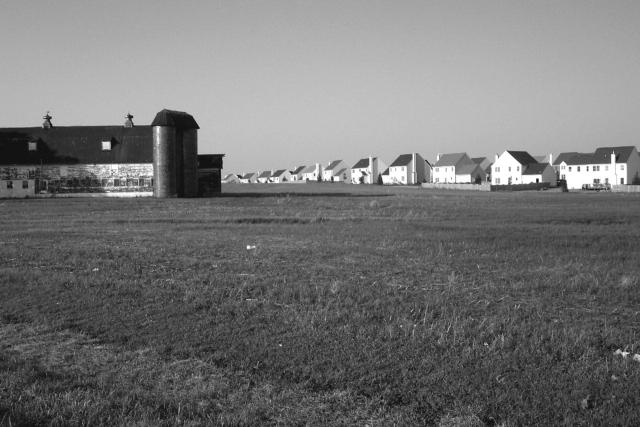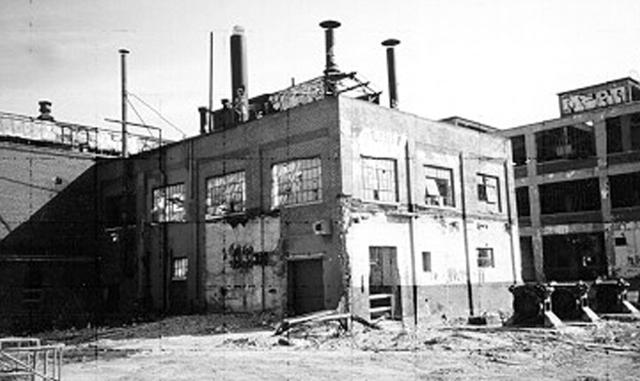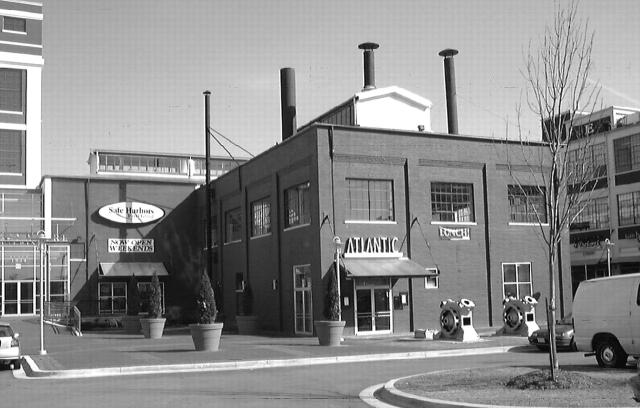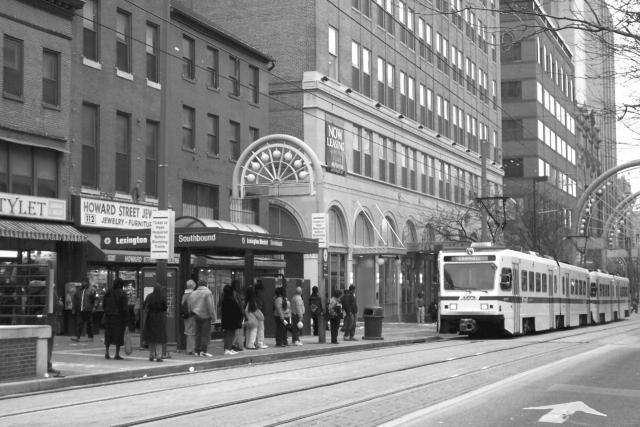FOR MANY, THE GREAT AMERICAN Dream is associated with large, single-family homes, lots of land, and a feeling of independence. Now, public health and urban planning professionals claim this vision has gone too far. They blame a phenomenon called sprawl for a host of problems, from obesity and traffic injuries to environmental destruction. A movement called Smart Growth is challenging the way we build, work, and live, and is encouraging us to look at communities not only as places to live but as vehicles to promote health and well-being.
SMART GROWTH AND CHOICES
According to Don Chen of Smart Growth America, a nationwide coalition of over 60 public interest groups, low-density suburban growth, or sprawl, has 4 dimensions: a population that is widely dispersed in low-density development; rigidly separated homes, shops, and workplaces; a network of roads marked by huge blocks and poor access; and a lack of well-defined, thriving activity centers, such as downtowns and town centers.1 Most of the other features usually associated with sprawl—a lack of transportation choices, dependence on the automobile, relative uniformity of housing options, and the difficulty of walking—are a result of these conditions.
There are many who defend low-density suburban growth because of the opportunities for home ownership and independence. Suburban neighborhoods away from commercial areas offer the opportunity to own large pieces of property. Such developments tend to be more homogenous, which some say contributes to better schools and lower crime rates. And while living in outlying suburbs necessitates private transportation, many say they prefer the independence and freedom of driving their own automobiles.
Sprawl has been criticized for being a financial and social drain. Outlying suburbs often require more costly infrastructure (roads, water, sewers, and other services); suburban development composed primarily of housing often lacks the tax base necessary to cover such expenses. Urban centers also pay a price when residents leave for the suburbs, depleting cities of economic and social diversity as well as a strong tax base.
Public health officials have voiced a number of concerns about sprawl’s impact on health and safety. Most notably, critics cite automobile dependence associated with sprawl for promoting sedentary lifestyle habits and contributing to traffic injuries and air quality problems.
Automobile dependence has been associated with an increasingly sedentary culture in the United States, which in turn generated an epidemic rise in obesity. In 2000, a total of 38.8 million American adults met the classification for obesity, according to the Centers for Disease Control and Prevention (CDC), putting themselves at risk for chronic diseases including diabetes, high blood pressure, coronary artery disease, osteoporosis, cancer, and stroke.2 Physical inactivity is an independent risk factor for chronic disease. People who are physically inactive are at a two- to threefold greater risk for premature mortality than their physically active counterparts.3,4
Motor vehicles are responsible for one third to one half of the smog in most metropolitan areas; over 113 million Americans live in cities with polluted air.5 Topping the health effects associated with air pollution, asthma affects approximately 17 million adults and over 4 million children in the United States.
About 41 000 Americans are killed every year on our nation’s roadways; approximately 13% of traffic fatalities are pedestrians or cyclists.6 Among CDC recommendations to reduce such fatalities are the use of pedestrian bridges and traffic islands, narrower streets, more sidewalks and pedestrian malls, and denser community areas that combine work, shopping, and residences—all Smart Growth measures currently being adopted in communities across the country.
Other concerns associated with sprawl focus on the environment: the extensive land consumption associated with sprawl has been criticized for habitat loss and fragmentation, wetland destruction, and degradation of air and water quality.
The Smart Growth movement involves professionals from many disciplines, including planners, designers, builders, transportation officials, crime prevention specialists, environmentalists, politicians, public heath advocates, and a range of citizen groups. Its advocates include the Environmental Protection Agency; private organizations like the Urban Land Institute, the Robert Wood Johnson Foundation, and the nationwide coalition Smart Growth America; a range of public health officials; pedestrian and biking advocates; and leaders at all levels of government. Such a broad coalition necessarily has varied goals, but the movement’s main objectives can be summarized as follows: improving quality of life for all citizens, promoting healthy behaviors, minimizing hazards to people, and protecting and restoring the natural environment.
“Smart Growth is so many different things. It's not just transportation; it's a mindset towards creating a more holistic community. We've talked about quality of life. And what has been more fundamental to quality of life than physical health?”
–Barbara McCann, Executive Director, Smart Growth America
Smart Growth strives to protect farmland and open space, revitalize neighborhoods, and provide more transportation choices. Smart Growth encourages reinvestment in existing communities, more efficient use of existing infrastructure, and transportation choices. It promotes compact development and the creation of mixed-use communities that integrate a range of housing and commercial services and serve a variety of income levels. However, a central theme in the Smart Growth movement is that of choice. Advocates stress that well-designed communities offer variety in housing, transportation, employment, and recreation.
Within public health, a parallel movement called Active Living emphasizes such elements as bicycle- and pedestrian-oriented design, traffic calming, mixed-use development, and “safe routes to school” programs that allow residents to integrate physical activity such as walking and bicycling into their daily lives.
SMART GROWTH AT THE LOCAL, STATE, AND FEDERAL LEVEL
Proponents of Smart Growth are most active at the local level, where land use decisions are usually made. Still, national and state policy is a significant part of the equation, as it can provide incentives or disincentives for local governments, set standards, and act as a watchdog. Democratic and Republican governors in states across the country are coordinating with local jurisdictions to reinvigorate existing communities and promote transportation planning and more environmentally sound land use. Anticipating the renewal of the federal Transportation Efficiency Act for the 21st Century (TEA-21), a range of constituencies, from grassroots to state and federal legislators, are pushing for investments in light rail and pedestrian and bicycle infrastructure.
Smart Growth initiatives are being pursued in communities across the country. A few examples are outlined below.
Local Initiatives
A river comes to life and a freeway overpass comes down.
Milwaukee’s Smart Growth has been driven by a mayor who is focused on building a vibrant community. Mayor John Norquist’s initiatives have included the removal of the elevated Park East Freeway spur and the cleanup and development of Milwaukee’s riverfront.
The freeway demolition project, initiated in April 2002, released 26 acres of riverfront for redevelopment and preserved traffic flow with a 3-lane boulevard and pedestrian bridge, according to Norquist.
Milwaukee’s RiverWalk project, launched in 1994, transformed a heavily industrialized and isolated riverfront area. A partnership between the city and downtown property owners turned the river into a city hub that has fueled a housing boom, spawned a number of new restaurants, shops, and green space, and in the process created a broader constituency for cleaning up the Milwaukee River.
Norquist emphasizes that the RiverWalk enhanced the community, not just because it introduced a walkway but because it is connected to the city’s street grid.
Smart Growth’s poster city.
Portland, Ore, has earned a reputation as the Smart Growth gold standard by its active citizenry. and leadership at local and state levels, including the enthusiastic participation of Oregon Congressman and bicycle enthusiast Earl Blumenauer.
Thirty years ago, Portland was strangled with traffic congestion. Under the leadership of then-mayor Neil Goldschmidt (later US secretary of transportation), the city revived its downtown area and surrounding neighborhoods, investing in a multimodal regional transportation system including an extensive light rail, a bus network, and the country’s first modern streetcar line.
“People must feel empowered on a level that is personal to them—individual communities have individual needs.”
–Rich Killingsworth, Director, Active Living by Design
The city was the first in the country to undertake a comprehensive Pedestrian Master Plan. Nearly 800 traffic-calming devices such as speed bumps and traffic circles and 221 miles of bikeways allow pedestrians and cyclists to commute safely to downtown.7
The city’s legendary parks and other green space benefit from a 26-year statewide land-use planning program marked by the use of urban growth boundaries and the preservation of forest land. Among the 100 largest cities in the United States, Portland was rated number one in meeting key Healthy People 2000 goals.8 “This achievement is not just about conventional preventive health care,” says Multnomah County Health Department Director Lillian Shirley, “but includes issues of housing, urban planning, and alternative transportation.”9
Public transit, mixed-use communities, and Cinderella stories.
According to Smart Growth America, transit-oriented development is an obvious way to integrate transportation and land-use planning, since it clusters housing and commercial activities around stations. Advocates claim that such development boosts transit ridership and provides a reliable market base for local businesses. Cities such as Denver and Dallas have created transit-oriented, mixed-use communities, and the public seems to be responding with enthusiasm.
Dallas has laid 44 miles of light rail, supporting 60 000 riders a day and spawning a trend in retail, residential, and office development around rail stations, explained Jack Wierzenski, an assistant vice president at Dallas Area Rapid Transit. In Denver, whose metropolitan area continues to grow at a rapid pace, a light rail system connects suburbs from all directions to the downtown, and a free shuttle bus runs the length of the downtown spine. A decaying shopping mall known as Cinderella City has been transformed into a transit-oriented, mixed-use community where apartments sit atop office and retail space, all of which are within walking distance of the Englewood light rail stop.
State Level Initiatives
Maryland.
In 2001, then–Maryland Governor Parris Glendening helped put the state on the cutting edge of the Smart Growth movement, creating a cabinet-level position that focused exclusively on transportation, land use, and growth issues, generating incentives to encourage Smart Growth, and signing legislation that prevented state funds from being used for infrastructure projects that induce sprawl. Maryland’s Office of Smart Growth serves as an information clearinghouse, developing outreach and education programs and assisting local officials, developers, the news media, and citizen groups. Most importantly, the office helps local jurisdictions, developers, and the public to prepare, finance, and develop projects that are consistent with Smart Growth policies.
Glendening’s Community Legacy program has awarded $15.5 million in revitalization grants, funding projects in 40 communities. Says former Maryland Smart Growth cabinet secretary Harriet Tregoning, “Where 80% of funds used to be used for building new schools, that percentage is now used to repair existing schools.” This type of renovation preserves green space and keeps schools close to residential centers.
“Neither the State nor local governmenets can afford to go it alone if we are to enhance the vitality of our communities and preserve the State's most valuable forests and farmland.”
–Maryland Governor's Office of Smart Growth11
To fulfill his goal of doubling transit ridership by 2020, Glendening allocated $50 million and provided financial incentives such as discounted land near rail stations. These steps helped to encourage commercial development and safety improvements near stations and provided people the option of living near their workplace. Bicycle and pedestrian initiatives received enhanced funding; open-space programs preserved 300 000 acres from development and acquired and restored parkland, forests, and wildlife corridors. Economic incentives provided to developers encouraged brownfields cleanup and development, again using existing infrastructure while improving distressed urban areas.
Glendening is now out of office, but the Office of Smart Growth has been retained by the current governor, Robert Ehrlich. Says Tregoning, if Erlich is like other governors who inherited Smart Growth initiatives from their predecessors, he will likely make these issues his own.
New Jersey.
Governor James McGreevey recently made his 2003 State of the State speech about Smart Growth, focusing on infill (development that maximizes use of existing infrastructure) and revitalization. Claiming that each day the state loses 50 acres to sprawl, McGreevey pledged legal and zoning tools to control and manage growth.11 The governor’s Smart Growth checklist includes a cabinet-level Smart Growth Policy Council, a “Smart Growth Shield” calling for the state attorney general to intervene when Smart Growth planning is challenged, and financial mechanisms that will enable conservation. McGreevey has vowed to preserve 20 000 acres of farmland a year, while upgrading 200 local parks, creating at least 2 state parks, and planting 100 000 trees.11 He has also called for invigorating urban centers, older suburbs, and rural towns by redeveloping brownfields and steering infrastructure spending to these areas.
“If you want to build in over-developed or protected areas we will do everything in our power to stop you. However, if you want to build and grow consistent with Smart Growth, then we will help you get regulatory approvals quickly and make sure the infrastructure is there to support you.”
–New Jersey Governor James McGreevey11
Federal Level Initiatives
The federal Environmental Protection Agency (EPA) has become a Smart Growth advocate, offering resources to help communities with environmental problem solving and growth planning through community grants and projects. The agency has established best-management practices for such issues as soil erosion and wastewater treatment, and works with state officials, city planners, and a range of advocacy and citizen groups on these problems.
The most significant piece of federal Smart Growth legislation on the table is TEA-3, the third iteration of the Intermodal Surface Transportation Efficiency Act, established by Congress in 1991 and set for renewal in September 2003. Currently referred to as TEA-21, the law has the potential to be a good source of funding for transit, bikes, and pedestrians, but faces significant roadblocks. The American Road and Transportation Builders Association wants increased funding of roads and highways, and President Bush’s budget request for the federal fiscal year beginning October 1, 2003, calls for a 6% hike in highway spending with no increase in federal transit spending.
According to the Surface Transportation Policy Project, the states are not investing enough of their federal transportation dollars into protecting people who walk. While 12% of all traffic deaths are pedestrians (13.6% if bicyclists are included), only 0.7% of federal transportation construction, operations, and maintenance funds are spent to ensure a safe walking environment.12
Alongside numerous advocacy groups, the fight for increased transit resources will be led by James Oberstar, a member of the House Transportation Committee, and Oregon Congressman Earl Blumenauer, who are both pushing to preserve and expand bicycle and pedestrian programs, mass transit, and air quality measures. Blumenauer has met with citizens in hundreds of communities throughout the United States as part of his Livable Communities Task Force, discussing ways to improve land use, the environment, and transportation. With Representatives Oberstar, Peter DeFazio, and Edward Kennedy, Blumenauer founded the Congressional Bike Caucus, a bipartisan group that provides congressional leadership to bicycle and pedestrian advocates.
THE FUTURE OF SMART GROWTH
Although the movement has gathered a strong following, not everyone is convinced that Smart Growth works. The organization Demographia, which refers to itself as “pro-choice, with respect to urban development,” argues that Smart Growth in fact limits choice and opportunity. The group asserts that initiatives such as urban growth boundaries and “development impact fees” increase housing costs, thereby reducing home ownership, especially for minorities. They are also skeptical about transit initiatives, contending that outside of downtown corridors, there is little that transit can do to reduce traffic congestion, and that, for the most part, public transportation is unable to compete with the convenience of the automobile.13
Peter Gordon, professor of planning and economics at the University of Southern California’s School of Urban Planning and Development, agrees, arguing that a major shift to transit is highly improbable, and predicting that higher densities will actually bring more congestion. Challenging the presumption that “suburbanites are living lives of quiet desperation and isolation,” Gordon insists that citizens are voting for spacious living, “so by all means let them have what they are voting for.”14
Smart Growth measures are still relatively new and untested. Many are hesitant to invest in something new. “If it’s not broken, why fix it? Behavior is hard to change,” says Rich Killingsworth, citing problems such as outdated building and zoning codes and cautious development communities.
Opinions on Smart Growth’s efficacy still vary, but it is clearly becoming a part of the urban revitalization landscape. One of its greatest assets may be its scope, encompassing so many elements and disciplines, and offering communities a range of choices according to their needs. For some, it might be extensive transit development to ease traffic congestion; for others, it might be a “safe routes to school” program that puts parents at ease and enables children to walk every day.
“Communities across America have stepped up to the plate by funding transit at record levels. At a time when the demand for increased investment in transit is so clearly evident at the local level, the federal government must continue [its commitment] to support those efforts of our state and local partners.”
–Letter signed by a bipartisan group of senators, urging President Bush to increase mass transit spending15
By emphasizing and enabling such elements as increased physical activity, healthier environments, and more interactive communities, Smart Growth has enormous potential to enhance the health of populations. Certainly, the public health field plays a vital role in defining and evaluating the indicators of Smart Growth that actually do improve health.
Advocates like Smart Growth America’s Barbara McCann and James Corless of the Surface Transportation Policy Project emphasize the need to get citizens involved and show them that Smart Growth is about choice in housing, transportation, and lifestyle. Smart Growth comes in all shapes and sizes, says Corless; “People are ready for it—it just needs to be presented in the right way.”
Figure 1.
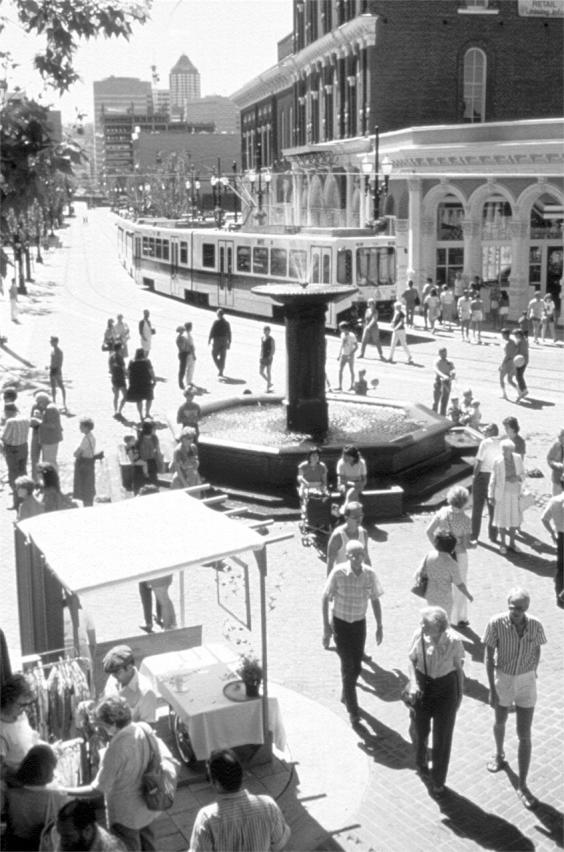
Saturday market at Skidmore Fountain in Portland, Ore.
Courtesy of TriMet, Portland, Ore.
Figure 2.
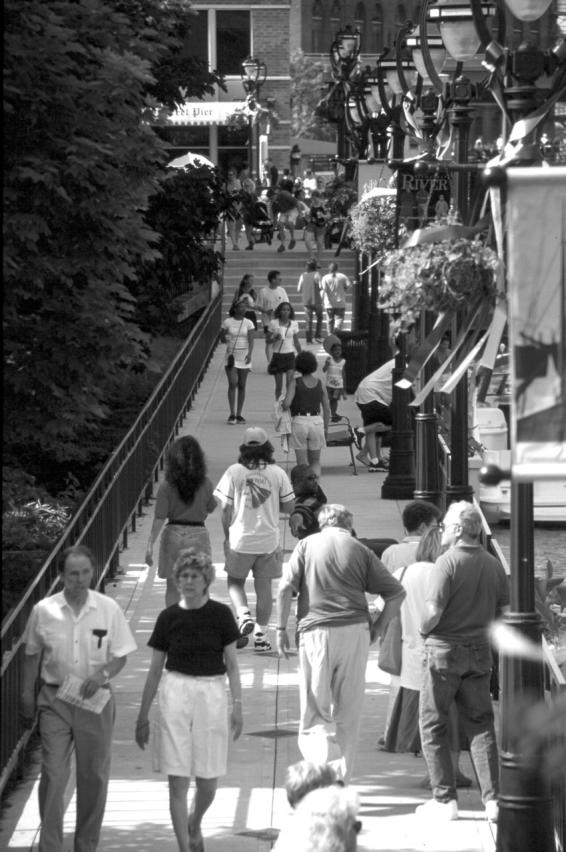
RiverWalk project, Milwaukee, Wis.
Courtesy of Milwaukee Department of City Development.
Figure 3.
Courtesy of Office of Smart Growth, Maryland Dept of Planning.
Figure 4.
Before and after images of a brownfield renovation: the American Can Company, Baltimore, Md.
Courtesy of Maryland Department of the Environment.
Figure 5.
Light rail in Baltimore, Md.
Courtesy of Office of Smart Growth, Maryland Department of Planning.
Acknowledgments
The author acknowledges the generous contributions of Catherine Staunton, MD, National Center for Environmental Health, Centers for Disease Control and Prevention; Barbara McCann, director of information and research, Smart Growth America; James Corless, senior campaign director for the Surface Transportation Policy Project; and Rich Killingsworth, director of Active Living By Design. Judy Corbett, executive director of the Local Government Commission, contributed substantial information on the evolution of Smart Growth and the public health community’s role therein.
References
- 1.Smart Growth America. Measuring sprawl and its impact: the character and consequences of urban expansion. Available at: http://www.smartgrowthamerica.org/sprawlindex/sprawlexecsum.html. Accessed February 7, 2003.
- 2.Centers for Disease Control and Prevention. Obesity trends, 1985–2001. Available at: http://www.cdc.gov/nccdphp/dnpa/obesity/trend/maps/index.htm. Accessed February 13, 2003.
- 3.Wei M, Kampert JB, Barlow CE, et al. Relationship between low cardiorespiratory fitness and mortality in normal-weight, overweight, and obese men. JAMA. 1999;282:1547–1553. [DOI] [PubMed] [Google Scholar]
- 4.Blair SN, Kampert JB, Kohl HW 3rd, et al. Influences of cardiorespiratory fitness and other precursors on cardiovascular disease and all-cause mortality in men and women. JAMA. In press. [PubMed]
- 5.Surface Transportation Policy Project website. Transportation and Health. Available at http://www.transact.org/library/factsheets/health.asp. Accessed March 13, 2003.
- 6.US Dept of Transportation, National Highway Traffic Safety Administration. Fatality Analysis Reporting System 2001. Available at: http://www-fars.nhtsa.dot.gov. Accessed March 17, 2003.
- 7.1998–2000 Biennial Report. Portland Office of Transportation. Portland, Ore.
- 8.Healthy People 2010: Understanding and Improving Health. Washington, DC: US Department of Health and Human Services; 2001. Also available at: http://web.health.gov/healthypeople/document. Accessed August 12, 2003.
- 9.Shirley L. Urban parks: what’s health got to do with it? Oregonian. 28October2002: C7.
- 10.Maryland Governor’s Office of Smart Growth: mission statement. Available at: http://www.smartgrowth.state.md.us/mission.htm. Accessed February 12, 2003.
- 11.Governor James McGreevey. State of the State speech. 14January2003. Available at: http://www.state.nj.us/sos2003/speech_text.html. Accessed February 27, 2003.
- 12.Senators urge Bush administration to provide resources for public transit systems; Congress set to reauthorize transit and highway programs in 2003. Available at: http://www.tea3.org/news.asp?id=28. Accessed February 4, 2003.
- 13.The growing smart legislative guidebook: model legislation threatens opportunity. Available at: http://www.demographia.com/db-grsmart.htm. Accessed March 3, 2003.
- 14.Reason online: free minds and free markets. Interview with Peter Gordon. Available at: http://reason.com/9806/fe.gordon.shtml. Accessed March 3, 2003.
- 15.New Jersey Future 2003: a checklist for smarter growth in 2003. Available at: www.njfuture.org/newsletter/2003q1.pdf. Accessed March 3, 2003.



